Story

THE THEME OF THE FILM CAN BE DESCRIBED WITH FOUR CONTRADICTIONS:
This strictly monitored border was not a border between two enemies. It was a border
between two states, “friends” from the socialist camp.
In 2007, in the time of united Europe, this border will be even more protected as it
will become the outer Shengen border.
Even if the border was open instantly, family ties were destroyed forever.
This border is very similar to Berlin wall – with one major difference: Berlin wall has
eventually fallen down!
BRIEF STORY OUTLINE:
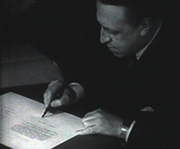
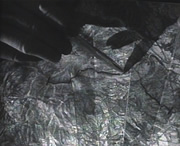
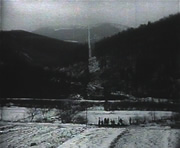
|
After the Soviet army got to Sub-Carpathian
Ukraine – the most eastern part of the former
Czechoslovakia – in november 1944 it had
already been decided about this part being
annexed to the Soviet Union. This had been
voted at the communist congress in Uzhorod
and shortly after that Sub-Carpathian Ukraine
became part of the Soviet Union. On the 29th
of June, 1945 pro forma agreement confirming
this status was made between the Soviet
Union and Czechoslovakia.
Despite the fact that Moscow was obliged to
respect the inner orders of Czechoslovakia
the Soviet soldiers on the Slovak territory
acted like violent conquerors.
This political act was a real disaster for the
citizens of Velke Slemence. During the night
of August 30, 1946, the village was divided
by the Red Army into two parts. One part
remained in the former Czechoslovakia; the
other one became a part of Ukraine (former
Soviet Union) and got a new name: Male
Slemence.
Barbed wire – mercilessly stretched between
houses – has divided cemetery and land, as
well as families for several decades. There
were even cases when parents were left on
one side, and their children on the other.
Cultivated land was divided and then
confiscated by the relevant states.
In 1949, the three meter high fence was even
charged with electric power. Watchtowers
were equipped with machine guns and
signalling devices. Despite all these measures,
families had a vivid communication. Most of
them spoke and understood Hungarian, while
border police did not. People used to sing
while working in the fields divided by the
barbed wire, and announce all important
information in this way. And thus both sides
knew who died, who had a new baby, who
got married. Yet they were not allowed to visit
each other… |
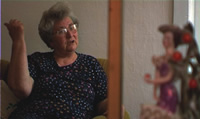 Mrs Kujikova was only a girl at the time of division. She was on holiday at her granny’s, and was not allowed to return to her parents in Ukraine after the border barriers were raised. Mrs Kujikova was only a girl at the time of division. She was on holiday at her granny’s, and was not allowed to return to her parents in Ukraine after the border barriers were raised.
She was not able to attend her mother’s funeral. Mother only saw her daughter from distance on the day of her wedding. The parents could only see their daughter’s first-born son over the tall fence.
„You’ve got a beautiful son“ they said.
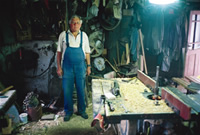 Mr Toth used to live on the Slovak side of the village. Here is his story: Mr Toth used to live on the Slovak side of the village. Here is his story:
While we were little children, soldiers lured us to come closer to the border offering us candies. Then they reported us to the authorities and received
vacation passes for a successful action on the border. Everybody wanted to get away from this mad house. I travelled to Bratislava to study, but my friends who stayed back here, are drinking heavily. Some of them became gasoline smugglers, selling gasoline for seventeen crowns, or joined traffickers to earn more money…
One of my friends got arrested by the police.
Another Tibor Toth’s story:
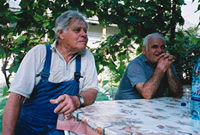 In the late eighties, when we went back from parties, we always went to the border. First we had to find out whether there was a real soldier in the watchtower, or a dummy wearing uniform. Ukrainian border soldiers used the dummy to mislead us when they left their posts and went drinking. If we found only dummy in the tower, we would walk backwards to the border leaving footprints in the smooth sand. It seemed as if someone ran from Ukraine into Slovakia. Then we climbed onto the roofs and started alarm signal… We were laughing like hell while those drunken Russians were running here and there… In the late eighties, when we went back from parties, we always went to the border. First we had to find out whether there was a real soldier in the watchtower, or a dummy wearing uniform. Ukrainian border soldiers used the dummy to mislead us when they left their posts and went drinking. If we found only dummy in the tower, we would walk backwards to the border leaving footprints in the smooth sand. It seemed as if someone ran from Ukraine into Slovakia. Then we climbed onto the roofs and started alarm signal… We were laughing like hell while those drunken Russians were running here and there…
Mrs Hornyakova lives in Slovakia as well. Her native house used to be right where the border line is. In deference to her family and the piece of land she put a cross on this place. She used to come here and pray and remember... After 10 years there was a long journey to the other side of the border .... Waiting in line on the border seemed neverending. To get to the place 6 meters away she had to walk 250 kilometers. Searching for the cross she had placed here was useless. There were now toilets for the customs officers instead. Neither she could find her father’s chestnut tree. She always used to take home a few chestnuts as a reminder. The border has ruined the symbols of the past as well as the faith in the future.
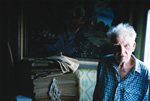 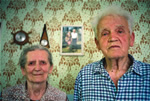 Peter Gilanyi, the oldest citizen of the village used to be a communist. The communist periodicals have an honourable place in his house, right below Peter Gilanyi, the oldest citizen of the village used to be a communist. The communist periodicals have an honourable place in his house, right below
the picture of Jesus Christ.
He is the village chronicler. Everything that happens on the border he has to tell his blind wife. Although she has been waiting for the border opening like all the other citizens she will never be able to see the other side.
  Mr Lizak lives only few metres from the border, in the last house of Velke Slemence. He spent all of his life there. As the border line moved, he was a citizen of the Czechoslovak Republic, Slovak state, then Hungarian Republic, then for five weeks a citizen of the Soviet Union, later a citizen of the Czechoslovak Socialist Republic, then Czechoslovak Federative Republic, and currently he is a citizen of the Slovak Republic. He was a citizen of seven different states while living all of his life in the same house, yard, garden… Mr Lizak lives only few metres from the border, in the last house of Velke Slemence. He spent all of his life there. As the border line moved, he was a citizen of the Czechoslovak Republic, Slovak state, then Hungarian Republic, then for five weeks a citizen of the Soviet Union, later a citizen of the Czechoslovak Socialist Republic, then Czechoslovak Federative Republic, and currently he is a citizen of the Slovak Republic. He was a citizen of seven different states while living all of his life in the same house, yard, garden…
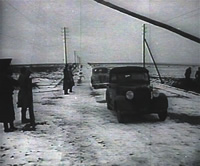 Citizens of Male Slemence confirmed that the accession to the Soviet Union was the worst thing that had ever happened to them. In line with Stalin’s policy, many of them were sent to labour camps, or transported to other regions of the Soviet Union. Russian families were then moved into their houses. The idea beyond this act was to weaken the local community, break family ties between both sides of the border, and deport former Czechoslovak citizens “affected by democracy” away from the region. Citizens of Male Slemence confirmed that the accession to the Soviet Union was the worst thing that had ever happened to them. In line with Stalin’s policy, many of them were sent to labour camps, or transported to other regions of the Soviet Union. Russian families were then moved into their houses. The idea beyond this act was to weaken the local community, break family ties between both sides of the border, and deport former Czechoslovak citizens “affected by democracy” away from the region.
Towards late fifties, the border protection was less radical. Religious citizens of Velke Slemence were allowed to cross the border and attend masses in the Orthodox Church in Male Slemence. People walked by watchtowers and soldiers carefully counted and reported their numbers.
After Slovakia´s independence and in line with Shengen Treaty, Slovak border was strengthened by soldiers again, and visa regime was introduced for Ukrainian citizens. Ukraine answered the same… Citizens of Slemence now have to travel few hundreds of kilometres either to Bratislava or Kiev to apply for expensive visa.
To fight illegal migrants, a new fence was built, and watchtowers are once again occupied by border guards. Illegal border crossing is organized mainly by Ukrainian mafia. Mafia traffickers have already bought a couple of houses in the surroundings, using them for refugees as their first shelters in the Slovak territory. Due to unpleasant economic situation, more and more young people leave Velke Slemence. There are no jobs in the village or its surroundings. Moreover, some entrepreneurs prefer Ukrainian employees – they give them lower salaries and pay no payroll taxes.
|